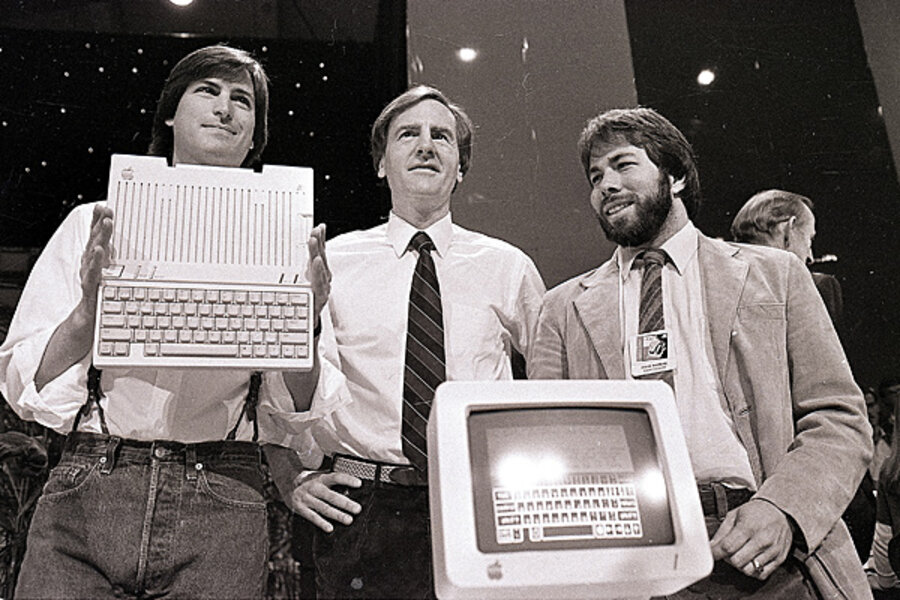Why Apple's '1984' commercial is still talked about today
Loading...
Long before the colorful, mysterious invitations to Apple’s Cupertino, Calif., headquarters for product announcements, Apple mastered the art of creating buzz about its innovations.
Prime example: the ad it aired during the 1984 Super Bowl that aptly played off George Orwell’s dystopian novel “1984." Using the simple themes of control versus freedom, and stagnation versus innovation, in a one-minute ad, Apple was able to spark viral curiosity just days before the release of its first Macintosh computer, and set a precedent-breaking tone that still prevails. The ad aired 30 years ago today.
The ad opens with a shot of a line of people in dark gray uniforms and shaved heads marching into an auditorium, where a talking head on a giant screen (a reference to Orwell’s character “Big Brother”) spouts propaganda about being “a garden of pure ideology ... secure from the pests of any contradictory force” and “one people with one will, one resolve, one course.” This scene cuts back and forth with a scene of a woman in bright orange shorts and a white top holding a sledgehammer and sprinting toward the auditorium, guards in close pursuit. When she gets close to the screen, she winds up, launches her sledgehammer, and the impact creates a blinding explosion. Apple cuts to the tagline: "On January 24th, Apple Computer will introduce Macintosh. And you'll see why 1984 won't be like '1984.' "
The idea was that Macintosh would revolutionize computing and that the future of technology would bring freedom, rather than control. The message was effective – the ad launched Apple as a computing powerhouse, and made the Mac one of the best-selling computers of its time.
Before it aired at the Super Bowl, however, it nearly didn’t make it to the screen. Apple had paid creative agency Chiat/Day $650,000 to create the ad as well as a second commercial. Steve Jobs was thrilled with the “1984” concept, but the board wasn’t as impressed – according to Business Insider, Chiat/Day copywriter Steve Hayden says the board was struck silent after they were initially shown the ad, and were so unimpressed they told the ad agency to sell the two-minute block of advertising time Apple had bought during the Super Bowl. Apple ad account manager Fred Goldberg also tested the commercial with a leading market research firm for effectiveness, and it scored a 5 on a 43-point scale.
However, Chiat/Day executives were so enamored with the commercial, they intentionally dragged their feet, and were only able to sell half the airtime (also note that Mr. Goldberg decided to keep the market research numbers to himself). The commercial had to run.
Shooting the commercial also proved to be a challenge. The commercial was directed by Ridley Scott, who had directed "Blade Runner" and "Alien" in years previous. To give the ad the same gritty, futuristic feel while shooting in London, the creative team hired 300 locals as extras, many actual skinheads, who got a bit antsy after three days of filming.
"The last day they started throwing the rocks at each other," Goldberg told CNN. "The security company had police dogs there [to control them.]"
But the team behind the ad ultimately succeeded and the commercial was a rousing success for Apple. The ensuing conversation and ad replay on news programs and talk shows resulted in what Apple estimated as more than $150 million of free airtime.
The commercial is also credited with ushering in more than just a new era for Apple. Some say it brought about the modern era of Super Bowl advertising, in which the commercials are as much a spectator sport as the game.
"This commercial was classically disruptive," says Timothy de Waal Malefyt, a professor at Fordham University, to Business Insider. "This wasn’t a machine where you were going to be kowtowed in the workplace, this was a machine for the young, innovative, entrepreneurial mind. It really inspires the creative individual to break free and start something different."








